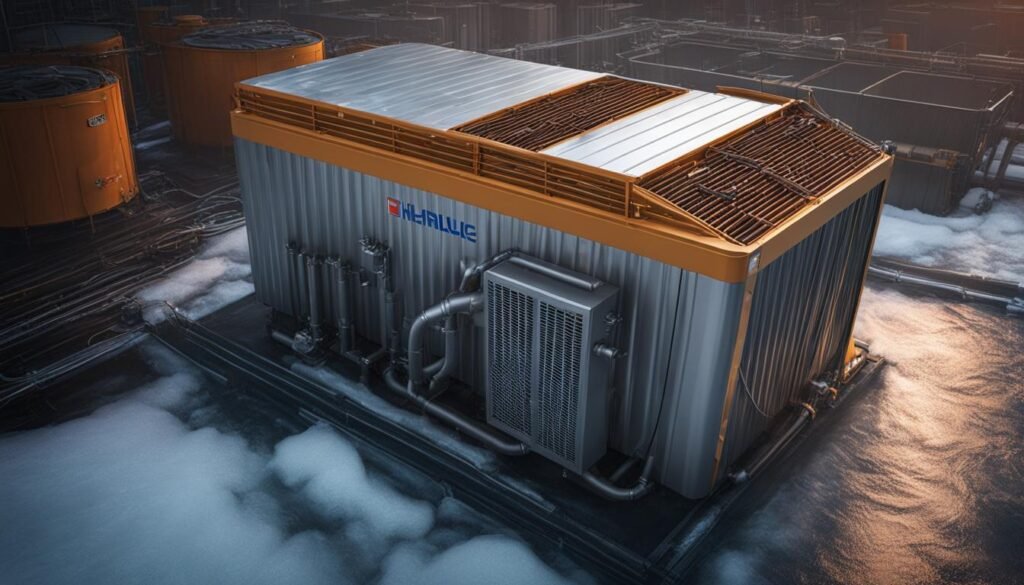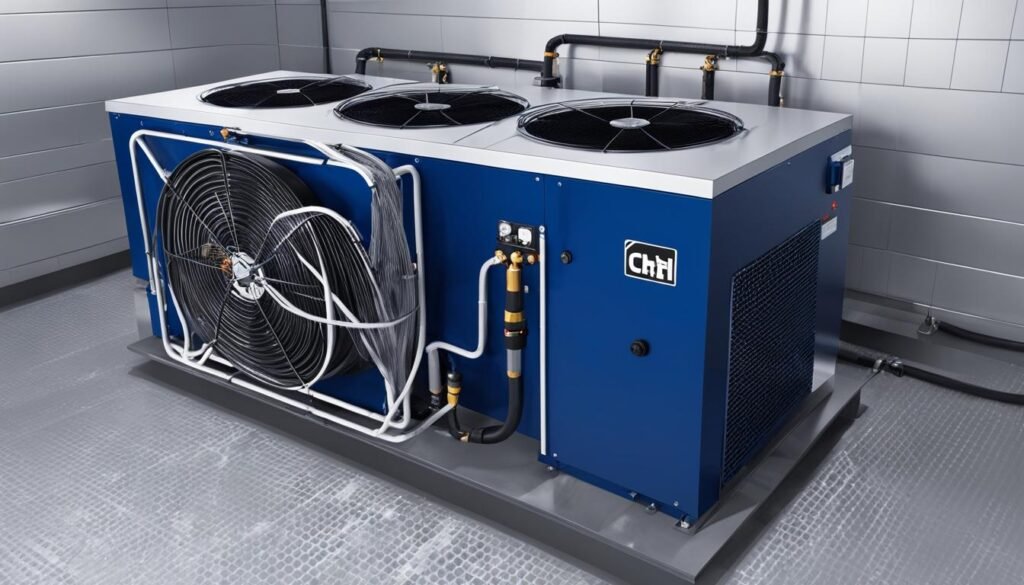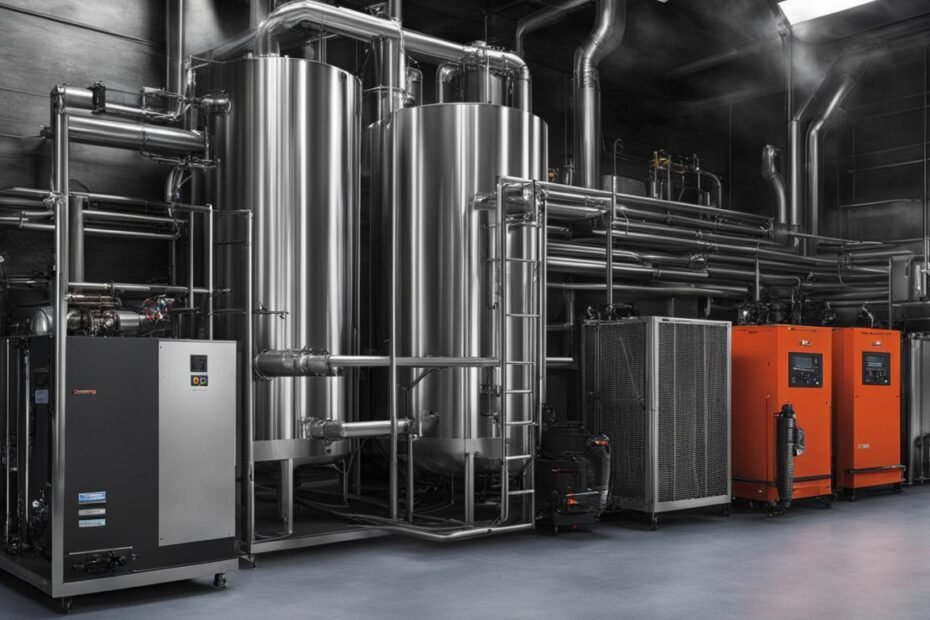Cooling down a large amount of hot liquid, such as wort used in homebrewing, can be time-consuming and challenging. Using an immersion chiller or ice bath can take a significant amount of time. Upgrading to a glycol chiller for an ice bath setup can provide more efficient cooling and precise temperature control. Counterflow or plate chillers are popular options for chilling wort quickly. However, using a pump is recommended for optimal performance, which can raise concerns about how to gravity feed the wort. Understanding how to use a glycol chiller and finding the right setup can enhance the brewing process and save time.
Key Takeaways:
- A glycol chiller for an ice bath setup provides more efficient cooling and precise temperature control compared to immersion chillers or ice baths.
- Counterflow or plate chillers are popular options for chilling wort quickly, but using a pump is recommended for optimal performance.
- Investing in a glycol chiller for an ice bath setup offers benefits such as consistent cooling, time savings, and uniform temperature distribution.
- A glycol chiller setup consists of components like a power pack, trunkline, and high-quality glycol.
- Setting up a glycol chiller requires proper positioning, temperature control, and insulation.
When choosing a glycol chiller for an ice bath setup, consider the specific requirements of the brewing process and the volume of liquid that needs to be cooled. Various manufacturers offer glycol chillers with different capacities and features. Ready-made glycol chiller systems range in cost, and DIY options can provide a more cost-effective solution. It’s important to assess the needs of the ice bath setup and consider the long-term benefits of investing in a glycol chiller.
How Does a Glycol Chiller Work?
A glycol chiller for an ice bath setup operates as a heat exchanger, similar to an immersion chiller. The wort is fed in through one port and flows out through another. Inside the chiller, plates separate the wort, and cold glycol is circulated through the pockets between the plates. The increased surface area allows for faster and more efficient cooling.
While some counterflow and plate chillers can be gravity fed, it is generally recommended to use a pump to ensure optimal performance. Gravity feeding the wort could potentially be done using an auto-siphon, although the practicality and speed of this method may differ.
Here is a summary of how a glycol chiller works:
- Wort is fed into the chiller through one port.
- Plates separate the wort inside the chiller.
- Cold glycol is circulated through the pockets between the plates.
- The increased surface area allows for faster and more efficient cooling.
- The cooled wort flows out through another port.
“A glycol chiller for an ice bath setup operates as a heat exchanger, separating the wort and circulating cold glycol to facilitate faster and more efficient cooling.”
Comparing Glycol Chillers
| Glycol Chiller | Efficiency | Pump Recommendation |
|---|---|---|
| Counterflow Chiller | High | Recommended |
| Plate Chiller | High | Recommended |
As shown in the table above, both counterflow and plate chillers have high efficiency and are recommended for use with a glycol chiller. The use of a pump is advised to ensure optimal performance in both cases.
Now that you understand the mechanics behind a glycol chiller, let’s explore the benefits of using one in an ice bath setup.
Benefits of a Glycol Chiller for Ice Bath
Investing in a glycol chiller for an ice bath setup offers several benefits. The precise temperature control provided by the glycol chiller allows for consistent cooling, which is crucial in various applications, such as homebrewing. Additionally, the efficient cooling capabilities of a glycol chiller can significantly reduce the time required to cool down a large volume of hot liquid, such as wort. This can save valuable time during the brewing process, allowing for more batches to be brewed in a shorter period. Moreover, a well-designed glycol chiller setup ensures uniform cooling throughout the ice bath, preventing any hotspots and resulting in a better brew.

With a glycol chiller for the ice bath, you can expect the following benefits:
- Consistent Cooling: The precise temperature control offered by the glycol chiller ensures that your ice bath maintains a stable and desired temperature throughout the cooling process.
- Time Efficiency: The efficient cooling capabilities of a glycol chiller significantly reduce the time required to cool down a large volume of hot liquid, such as wort. This enables you to complete more brewing batches in less time.
- Uniform Cooling: A well-designed glycol chiller setup ensures that the ice bath provides uniform cooling throughout. This eliminates hotspots and ensures that your brew is of higher quality.
Whether you are a homebrewer or need precise temperature control for other applications, using a glycol chiller for your ice bath setup is a smart investment. It not only saves time but also ensures consistent and efficient cooling, resulting in better brewing outcomes.
Components of a Glycol Chiller Setup
A glycol chiller setup for an ice bath consists of several key components. These components work together to ensure efficient cooling and precise temperature control. Let’s take a closer look at each component:
Power Pack
The power pack is the heart of the glycol chiller system. It is responsible for chilling the food-grade glycol to the desired temperature. This chilled glycol will flow through the system, extracting heat and cooling down the ice bath. To ensure optimal performance, it’s important to choose a power pack with sufficient cooling capacity for your specific application.
Trunkline or Python
The trunkline (also known as python) acts as a conduit for both the beer and glycol lines. It is responsible for delivering the cooled glycol from the power pack to the ice bath setup. The trunkline ensures efficient cooling by maintaining the flow of glycol throughout the system. It is important to choose a trunkline that can handle the necessary glycol flow rate and effectively distribute the chilled glycol.
Glycol
The glycol used in the chiller system must be of high quality to ensure optimal performance and safety. It is recommended to use 100% USP Grade Propylene Glycol, which not only provides excellent cooling properties but also acts as a lubricant to extend the lifespan of the pump. Using high-quality glycol helps maintain the efficiency and reliability of the chiller system.
Trunkline Components
The trunkline typically includes various components to ensure the effectiveness of the chiller system. These components include:
- Beer lines: These are the lines used to transport the beer from the fermenter to the dispensing system.
- Color-coded polyethylene glycol lines: These lines are specifically designed to transport the chilled glycol throughout the system.
- Moisture barrier wrap: This wrap helps prevent condensation and moisture buildup on the trunkline.
- Foil wrap: Foil wrap provides additional insulation and helps maintain the desired temperature within the trunkline.
- Insulation: Insulation ensures minimal heat transfer and helps maintain the cooling efficiency of the chiller system.
- Outside barrier jacket: The outside barrier jacket provides protection for the trunkline and helps maintain its integrity.
By utilizing these trunkline components, you can ensure efficient cooling and minimize heat transfer throughout the chiller system.
Components of a Glycol Chiller Setup
| Component | Description |
|---|---|
| Power Pack | The heart of the glycol chiller system that chills the glycol to the desired temperature. |
| Trunkline or Python | The conduit that delivers the cooled glycol from the power pack to the ice bath setup. |
| Glycol | High-quality, food-grade glycol used in the chiller system for efficient cooling. |
| Trunkline Components | Beer lines, color-coded polyethylene glycol lines, moisture barrier wrap, foil wrap, insulation, and outside barrier jacket, ensuring efficient cooling and minimal heat transfer. |
Setting Up a Glycol Chiller for Ice Bath
-
Positioning the Chiller Components:
When setting up a glycol chiller for an ice bath, it’s essential to position the condenser and other components correctly. Take the time to move the copper tubing gently and slowly, ensuring optimal surface area and avoiding any bending of the condenser fins. This careful placement ensures efficient cooling and prevents damage to the chiller.
-
Mounting for Convenience:
Consider mounting the glycol chiller on a piece of plywood to make it easier to move around your brewing area. This allows for flexibility in positioning the chiller and ensures it remains stable during operation.
-
Regulating Temperature:
Use an external temperature controller, such as an Inkbird or Ranco, to regulate the temperature of the glycol chiller. This ensures that the ice bath maintains the desired temperature consistently, providing efficient cooling for your brewing process.
-
Proper Hose Installation:
When connecting the glycol chiller to the fermenter, ensure that the glycol hoses are properly installed and secure. Use pipe foam insulation to prevent sweating and maintain stable temperatures throughout the setup.
By following these steps, you can set up an efficient glycol chiller for your ice bath, enhancing the cooling process and improving your brewing experience.

| Advantages of Setting Up a Glycol Chiller for an Ice Bath | Considerations for Setting Up a Glycol Chiller |
|---|---|
| 1. Provides precise temperature control | 1. Properly position chiller components |
| 2. Increases efficiency in cooling wort | 2. Mount chiller on a stable surface |
| 3. Ensures uniform cooling throughout the ice bath | 3. Use an external temperature controller |
| 4. Saves time during the brewing process | 4. Install glycol hoses with insulation |
Choosing the Right Glycol Chiller
When it comes to selecting the best glycol chiller for your ice bath setup, there are several factors to consider. Every brewing process has unique requirements, and the volume of liquid that needs to be cooled plays a crucial role in determining the right chiller for your needs. With various manufacturers offering a wide range of glycol chillers with different capacities, it’s important to choose wisely.
Firstly, consider the size of your ice bath. A larger ice bath will require a chiller with a higher capacity to effectively cool the liquid. Ensure that the chiller you select can handle the volume of liquid you typically work with during the brewing process.
Temperature control capabilities are essential for maintaining the desired temperature in your ice bath. Look for a glycol chiller that offers precise temperature control, allowing you to set and maintain the optimal cooling temperature throughout the brewing process.
Additionally, consider the number of pumps included in the chiller. Having multiple pumps can enhance the functionality and efficiency of your ice bath setup. They can enable you to pump the glycol through different lines, ensuring uniform cooling and preventing any temperature fluctuations.
Moreover, choosing a reliable brand is crucial to ensure the performance and longevity of your glycol chiller. Consider reputable manufacturers with a proven track record in the industry. Reading customer reviews and seeking recommendations from other brewers can also help you make an informed decision.
Lastly, ensure that the glycol chiller you choose meets all necessary safety and quality standards. Look for certifications and compliance with industry regulations to ensure that your chiller operates safely and efficiently.
By considering these factors and selecting the best glycol chiller for your ice bath setup, you can enhance the brewing process, improve cooling efficiency, and enjoy consistent and high-quality results.
DIY Glycol Chiller for Ice Bath
For those who prefer a more cost-effective option or enjoy DIY projects, it is possible to build a glycol chiller for an ice bath setup using readily available materials. One DIY option involves repurposing the condenser from an air conditioner unit. The concept is relatively straightforward, involving using the condenser to chill a bath of glycol. Building a DIY glycol chiller requires disassembling the AC unit, modifying certain parts, positioning the condenser within the ice bath setup, and using an external temperature controller. However, it is crucial to ensure that the DIY glycol chiller is constructed safely and meets necessary electrical and plumbing standards.

Components and Steps for Building a DIY Glycol Chiller
- Obtain an air conditioner (AC) unit with a functioning condenser.
- Ensure the AC unit is disconnected from any power source.
- Disassemble the AC unit carefully, taking note of the components.
- Retrieve the condenser and clean it to remove any dust or debris.
- Modify the condenser tubing as needed to fit the ice bath setup.
- Position the condenser within the ice bath setup, ensuring it is securely held in place.
- Connect the condenser tubing to the ice bath system, ensuring a proper seal.
- Install an external temperature controller to regulate the chiller’s temperature.
- Test the DIY glycol chiller to ensure it is working effectively and safely.
Building a DIY glycol chiller can be a rewarding project and a cost-effective solution for those interested in creating their ice bath setup. However, it is important to follow safety guidelines and ensure that the chiller complies with electrical and plumbing standards. Taking the time to plan and execute the build properly will result in a functional and efficient glycol chiller for your ice bath system.
Cost and Considerations of a Glycol Chiller for Ice Bath
When considering a glycol chiller for your ice bath setup, there are several cost and practicality factors to take into account. The price of ready-made glycol chiller systems can range from several hundred to several thousand dollars, depending on the brand, capacity, and additional components needed. If you’re looking for a more budget-friendly option, a DIY glycol chiller can be an alternative. However, keep in mind that constructing your own chiller requires time, effort, and possibly some technical skills.
Prior to making a decision, it is essential to evaluate your specific ice bath setup and assess your long-term brewing needs. Investing in a glycol chiller offers efficient temperature control and saves time during the brewing process. Additionally, regular maintenance and upkeep should be factored in to ensure optimal performance and longevity of the system.
While the upfront cost of a glycol chiller may seem like a significant investment, the benefits in terms of precision cooling, consistent temperature control, and time savings can outweigh the expense. Carefully consider your brewing goals, the volume of liquid you need to cool, and the frequency of your brewing operations to determine the most cost-effective and efficient glycol chiller for your ice bath setup.
FAQ
How does a glycol chiller work?
A glycol chiller for an ice bath setup operates as a heat exchanger. The wort or liquid to be cooled is fed into one port and flows out through another. Inside the chiller, plates separate the wort, and cold glycol is circulated through the pockets between the plates. The increased surface area allows for faster and more efficient cooling.
What are the benefits of using a glycol chiller for an ice bath?
A glycol chiller provides precise temperature control, ensuring consistent cooling. It also significantly reduces the time required to cool down a large volume of hot liquid. Additionally, a well-designed glycol chiller setup ensures uniform cooling throughout the ice bath, resulting in a better brew.
What components are included in a glycol chiller setup?
A glycol chiller setup consists of a power pack for chilling the glycol, trunkline or python for delivering the cooled glycol to the ice bath setup, and high-quality glycol that acts as a lubricant. Trunkline typically includes beer lines, polyethylene glycol lines, moisture barrier wrap, foil wrap, insulation, and an outside barrier jacket.
How do you set up a glycol chiller for an ice bath?
Position the condenser and other components correctly within the ice bath setup, ensuring optimal surface area. Mount the chiller on a piece of plywood for easier movement. Use an external temperature controller to regulate the chiller’s temperature, and properly install the glycol hoses with insulation to prevent sweating.
How do you choose the right glycol chiller for an ice bath setup?
Consider the specific requirements of the brewing process, the volume of liquid to be cooled, and the desired temperature control capabilities. Choose a reliable brand and ensure that the glycol chiller meets necessary safety and quality standards.
Can you build a DIY glycol chiller for an ice bath?
Yes, it is possible to build a DIY glycol chiller using readily available materials and repurposing the condenser from an air conditioner unit. However, it is crucial to ensure that the DIY glycol chiller is constructed safely and meets necessary electrical and plumbing standards.
What is the cost of a glycol chiller for an ice bath setup?
The cost can vary depending on the brand, capacity, and additional components needed. Ready-made glycol chiller systems range from several hundred to several thousand dollars. DIY options provide a more cost-effective solution but require time, effort, and potentially some technical skills.
What should be considered when investing in a glycol chiller for an ice bath setup?
Assess the specific needs of the ice bath setup and consider the long-term benefits. Additionally, maintenance and upkeep should be taken into consideration to ensure optimal performance and longevity of the system.
